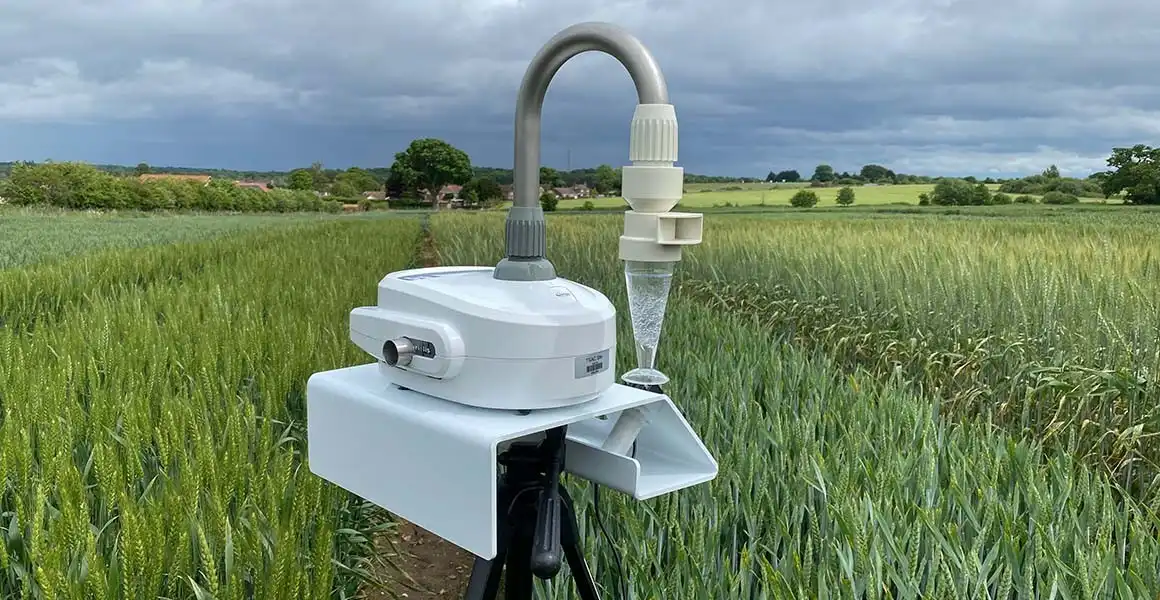Plant infections can now be detected in our crops before they’re even visible.
By identifying the DNA in spores floating through the air, it’s hoped a new technology called AirSeq can help farmers to tackle crop diseases more effectively while using fewer chemicals.
Airborne DNA could be crucial to protecting our food security.
Every year up to 40% of the world’s crops are lost to pests and diseases, which costs farmers hundreds of billions of pounds. Over four million tonnes of agricultural pesticides are used worldwide each year to try and suppress these threats, which takes its toll on the soil, water, and even ourselves.
In many cases, pesticides have little impact on stopping infections. Many diseases are only detected once plants start showing symptoms, at which point it’s often too late to save them.
Now, researchers at the Natural History Museum and the Earlham Institute have developed a new way of detecting these infections before they become a problem. Known as AirSeq, the device sucks in thousands of litres of air to identify the telltale DNA fragments of disease-causing fungi.
Testing in the east of England has shown that AirSeq can track how levels of this DNA fluctuate over the year. Dr Matt Clark, one of the co-authors of the new research, says that this could allow farmers to take action when the risk of infection is at its highest.
“At the moment, farmers spray their crops with fungicides to make their plants inhospitable to possible fungal infections,” Matt says. “But as different crops are resistant to different pathogen strains, this isn’t always necessary.”
“AirSeq can detect which spores are present and how abundant they are, which would allow farmers to see whether or not they need to use fungicides. This means farmers can spray their crops more efficiently, saving them money and promoting more sustainable farming.”
The findings of the study were published in the journal Current Biology.
The rising risk of fungal diseases
A few hundred years ago, farming was very different to how it is now. Farmers grew a mixture of different crops on relatively small areas of land. This variety of crops meant that farms were more resilient to potential diseases but at a cost of lower yields.
Today, many fields are monocultures in which farmers grow a single species across a vast area. While this makes farming more efficient, it increases the risk of disease. Infections can spread like wildfire through the plants, especially in plants that have very similar genetics.
Fungi are some of the most significant causes of plant infections. Fungal diseases like stem rust and spot blotch kill vast numbers of crops, with the losses estimated to be enough to feed anywhere between 600 million to four billion people for an entire year.
These losses are only expected to grow as a result of climate change, making combatting fungal disease more important than ever. However, just using more chemicals is not the answer. Just like bacteria becoming immune to antibiotics, fungi can also become resistant to fungicides.
“If fungicides are overused, the fungi which survive can develop an immunity to them,” Matt explains. “Some fungicides can also affect hormone production in animals, so increasing their use could also represent a risk to our health.”
“Some key fungicides are now being banned in the EU as a result. As these chemicals are phased out, it’s even more important to use the remaining options sparingly to prevent fungicide resistance.”
Issues like these inspired the team to develop the AirSeq technology. What began as a project to examine how spores moved between fields changed into the active monitoring of crop diseases through their airborne DNA.
What can AirSeq do?
AirSeq works by sucking air through a series of filters, with airborne particles ending up in a collection fluid. This fluid is then concentrated and used for DNA extraction and sequencing to find out what was in the air.
To prove it could work, the team first tested AirSeq’s ability to detect the bacteria Bacillus thuringiensis (Bt) in a wind tunnel. The bacterium was released at gradually higher levels into the air, with increasing levels of Bt DNA captured by the device and detected by sequencing.
Having proven the technology in a controlled environment, it was time to test AirSeq in the field. The device sampled the air around fields of wheat, barley and peas over a month and a half to see what it could detect.
“Our approach is to sequence everything that’s in the air, rather than focusing on certain genes or sequences,” Matt explains. “If we only sequence certain genes or species, then it’s possible to miss what’s not being looked for.”
“This method can detect anything, including new and unexpected strains of disease. In the long term, it could allow us to see how these pathogens are evolving.”
The AirSeq trial revealed DNA from a variety of different diseases, including those caused by fungi and bacteria. These included common diseases of wheat in the UK like powdery mildew and septoria leaf blotch, as well as more uncommon ones like stem rust.
The levels of pathogens appeared to be associated with the climate and weather, with higher humidity and rainfall linked to an increase in fungal spores.
The team now hope to continue developing AirSeq to a point where it can be rolled out to farmers across the world. Their ultimate aim is to produce a stand-alone device that can constantly monitor the air for signs of disease.
This could help farmers to take targeted action to reduce crop losses, and go some way to reducing world hunger.
Read the paper: Current Biology
Article source: Natural History Museum, London
Author: James Ashworth
Image: AirSeq sucks air through a series of filters, with airborne particles ending up in a collection fluid for futher analysis. Credit: The Trustees of the Natural History Museum, London.






